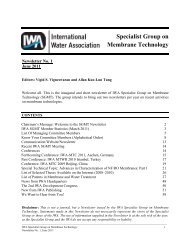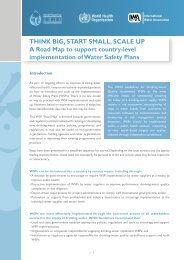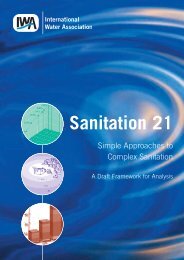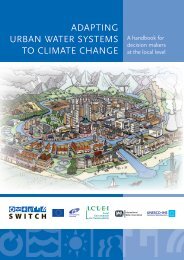Specialist Group on ANAEROBIC DIGESTION Newsletter - IWA
Specialist Group on ANAEROBIC DIGESTION Newsletter - IWA
Specialist Group on ANAEROBIC DIGESTION Newsletter - IWA
You also want an ePaper? Increase the reach of your titles
YUMPU automatically turns print PDFs into web optimized ePapers that Google loves.
Sulfate reducing biological processes in biofilms for metal precipitati<strong>on</strong><br />
by Marisol Gallegos García (mgg@ipicyt.edu.mx)<br />
Instituti<strong>on</strong>:<br />
Instituto Potosino de Investigación Científica y Tecnológica.<br />
División de Ciencias Ambientales.<br />
Camino a la Presa San José 2055. Lomas 4ª Sección.<br />
San Luis Potosí, SLP. México. 78216<br />
Supervisors:<br />
Dr. Elías Razo-Flores<br />
Dra. Mª. Lourdes Berenice Celis-García<br />
Abstract:<br />
The envir<strong>on</strong>ment c<strong>on</strong>taminati<strong>on</strong> by heavy metals is an important matter due to its negative impact over the<br />
public health, the envir<strong>on</strong>ment and the ec<strong>on</strong>omy. Sulfate reducti<strong>on</strong> has become and alternative for the treatment<br />
of wastewaters that c<strong>on</strong>tain heavy metals. The general objective of this work was to study the applicati<strong>on</strong> of<br />
biological sulfate reducti<strong>on</strong> processes in biofilm reactors for metal precipitati<strong>on</strong> and recovery of the metal<br />
sulfides in <strong>on</strong>e step. First of all, the competence between methanogens and sulfate reducers was studied in an<br />
UASB reactor that was operated for over 240 days, for the development of sulfate reducing biomass from a<br />
methanogenic granular sludge. The chemical oxygen demand (COD) removed by sulfate reducti<strong>on</strong> was 20% and<br />
the total sulfide c<strong>on</strong>centrati<strong>on</strong> reached in the reactor was 310 mg/L. The specific sulfate reducing and<br />
methanogenic activities of the granular sludge pointed out to the development of sulfate reducing bacteria<br />
(SRB). The presence of SRB that oxidize incompletely the substrate to acetate, allowed the permanence of<br />
methanogens that were not limited by substrate, and in c<strong>on</strong>sequence were not completely displaced by the SRB<br />
at the end of reactor operati<strong>on</strong>. Afterwards, a down-flow fluidized bed reactor (DFFB) was proposed for the<br />
precipitati<strong>on</strong> and recovery of metals. The DFFB reactor was operated c<strong>on</strong>tinuously during 320 days and<br />
precipitati<strong>on</strong> efficiencies over 99.0% of Fe, Zn and Cd were obtained. The recovered metal sulfides amounted to<br />
90% of the theoretical mass expected to be precipitated; pyrite (FeS), sphaleryte (ZnS) and greenockite (CdS)<br />
predominated in the precipitate. The metal loading rate did not affect the reactor performance even at pH values<br />
as low as 5.0. The COD removal efficiency was close to 54%, which suggested an incomplete substrate<br />
oxidati<strong>on</strong> by the immobilized SRB, this was c<strong>on</strong>firmed by the high c<strong>on</strong>centrati<strong>on</strong> of acetate in the effluent and<br />
the absence of alkalinity producti<strong>on</strong>. Finally, the development of a sulfate reducing biofilm able to oxidize<br />
completely the substrate was studied. To achieve this, a selecti<strong>on</strong> pressure by substrate was used; three different<br />
assays were carried out in the DFFB reactor that was fed with a mixture of acetate/lactate with the following<br />
ratios <strong>on</strong> a COD basis: 50/50, 80/20 and 90/10 during 21 days. The best biofilm performance in terms of COD<br />
removal efficiency (71%) and sulfide producti<strong>on</strong> rate (2.9 mg H 2 S/L-h) was obtained with the biofilm developed<br />
in the experiment with the 90/10 acetate/lactate ratio. With this biofilm, the reactor was operated c<strong>on</strong>tinuously<br />
110 days. When the pH in the fed was decreased to 4.0, any inhibitory effect was observed over the SRB, as the<br />
reactor performance showed which achieved COD and sulfate removal efficiencies of 80 and 42%, respectively.<br />
The alkalinity produced by the complete oxidati<strong>on</strong> of the substrate neutralized the influent pH, and maintained a<br />
pH of 7.0 within the reactor. This work is the first to report the precipitati<strong>on</strong> and recovery of metals as metal<br />
sulfides in <strong>on</strong>e step and the development, in a short period of time, of a SRB biofilm able to oxidize completely<br />
the substrate.<br />
Link to Thesis: http://www.ipicyt.edu.mx/storage-sipicyt/materialbiblioteca/GallegosGarc%edaMarisol.pdf<br />
List of publicati<strong>on</strong>s:<br />
Gallegos-García, M., et al. (2009). Precipitati<strong>on</strong> and recovery of metal sulfides from metal c<strong>on</strong>taining acidic<br />
wastewater in a sulfidogenic down-flow fluidized bed reactor. Biotechnol Bioeng. 102, 91-99.<br />
doi.wiley.com/10.1002/bit.22049<br />
Gallegos-García, M., et al. (2008). Competencia por sustrato durante el desarrollo de Biomasa sulfato reductora<br />
a partir de un lodo metanogénico en un reactor UASB. Sometido, a la Revista Internaci<strong>on</strong>al de<br />
C<strong>on</strong>taminación Ambiental.<br />
Gallegos-García, M., et al. (In preparati<strong>on</strong>). Formati<strong>on</strong> of a sulfate-reducing biofilm of complete oxidati<strong>on</strong> of the<br />
substrate for the treatment of a synthetic effluent with sulfate.<br />
<strong>IWA</strong> <str<strong>on</strong>g>Specialist</str<strong>on</strong>g> <str<strong>on</strong>g>Group</str<strong>on</strong>g> <strong>on</strong> Anaerobic Digesti<strong>on</strong><br />
18 June 2009 <strong>Newsletter</strong>

















